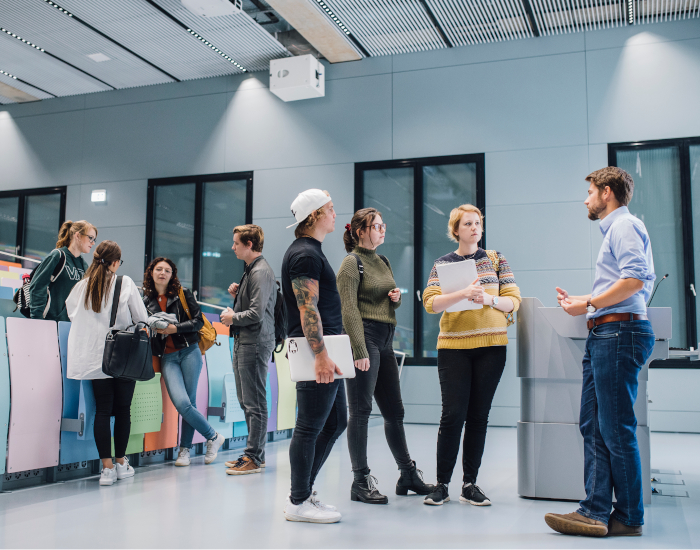Synchronous communication in the teaching and learning context
What is synchronous communication?
Synchronous communication takes place in real time between two or more people (see e-teaching.org). This simultaneous communication can take place face-to-face or in digital space, e.g. in a chat, audio or video conference.
Successful communication in face-to-face teaching
Successful synchronous communication in face-to-face teaching first requires rhetorical skills. Take a look at the following resources for tips on voice and speaking techniques as well as presentation techniques.
- High Noon - Didactics at lunchtime: Voice and speaking skills (uniTUBE video in German)
- High Noon - Didactics at lunchtime: Presentation techniques for the university (uniTUBE video in German)
Communicating as an instructor is not just about presenting content professionally. Rather, it is about establishing a relationship with the students, creating an atmosphere conducive to learning and being able to resolve difficult situations. You can find suggestions for this in the resources linked below.
- High Noon - Didactics at noon: Communication and interaction in courses (uniTUBE video in German)
- High Noon - Didactics at lunchtime: Dealing with resistance/conflict resolution (uniTUBE video in German)


Successful communication in video conferences
Pedagogical preparation
A video conference can be used to emulate parts of the synchronous teaching/learning setting of a face-to-face course online. Consider what objectives you are pursuing with a video conference and what can be done better asynchronously, e.g. via Moodle. Keep input phases as short as possible (15-20 minutes each) and set specific interaction points. So-called "ice-breaker activities", for example, are suitable for "warming up" students and providing a low-threshold introduction to a topic. In order to increase social presence and the group feeling, (digital) rounds of introduction are recommended. Pay particular attention to the first two phases in Gilly Salmon's "5-stage model" of online teaching (access & motivation and online socialization).
Activation formats such as surveys and methods such as "think-pair-share" or collaborative brainstorming can create diversity and increase the attention curve. They can also be used to obtain feedback from students. The audience response tool Particify can support this.
Organizational preparation
- Announce the planned video conference and access to it early enough, preferably in an email or in the message forum on Moodle.
- Inform the students in advance about the required equipment (device with stable internet connection, microphone, camera if necessary) and, if possible, provide instructions for the video conferencing tool used.
- Think about a plan B in advance in case technical or other difficulties arise.
Technical preparation
- Familiarize yourself with the video conferencing tool in advance and test the various functions such as switching the microphone and camera on or off, screen sharing or slide upload, setting up break-out rooms, etc. (e.g. with colleagues).
- If possible, organize a headset with a microphone, as audio quality is one of the most important factors for a successful video conference and integrated microphones on laptops or the microphone of the webcam often transmit a lot of background noise and can therefore create barriers.
→ Available video conferencing tools at the University of Graz
Further resources
→ Videoconferences in online teaching: Why, what and how? (quick guide)
→ Camera use in video conferences: The right choice for your online teaching (infographic)
→ Particify: Interactive face-to-face teaching with digital surveys (short guide)
→ Digital rounds of introduction: A foundation for online socialization